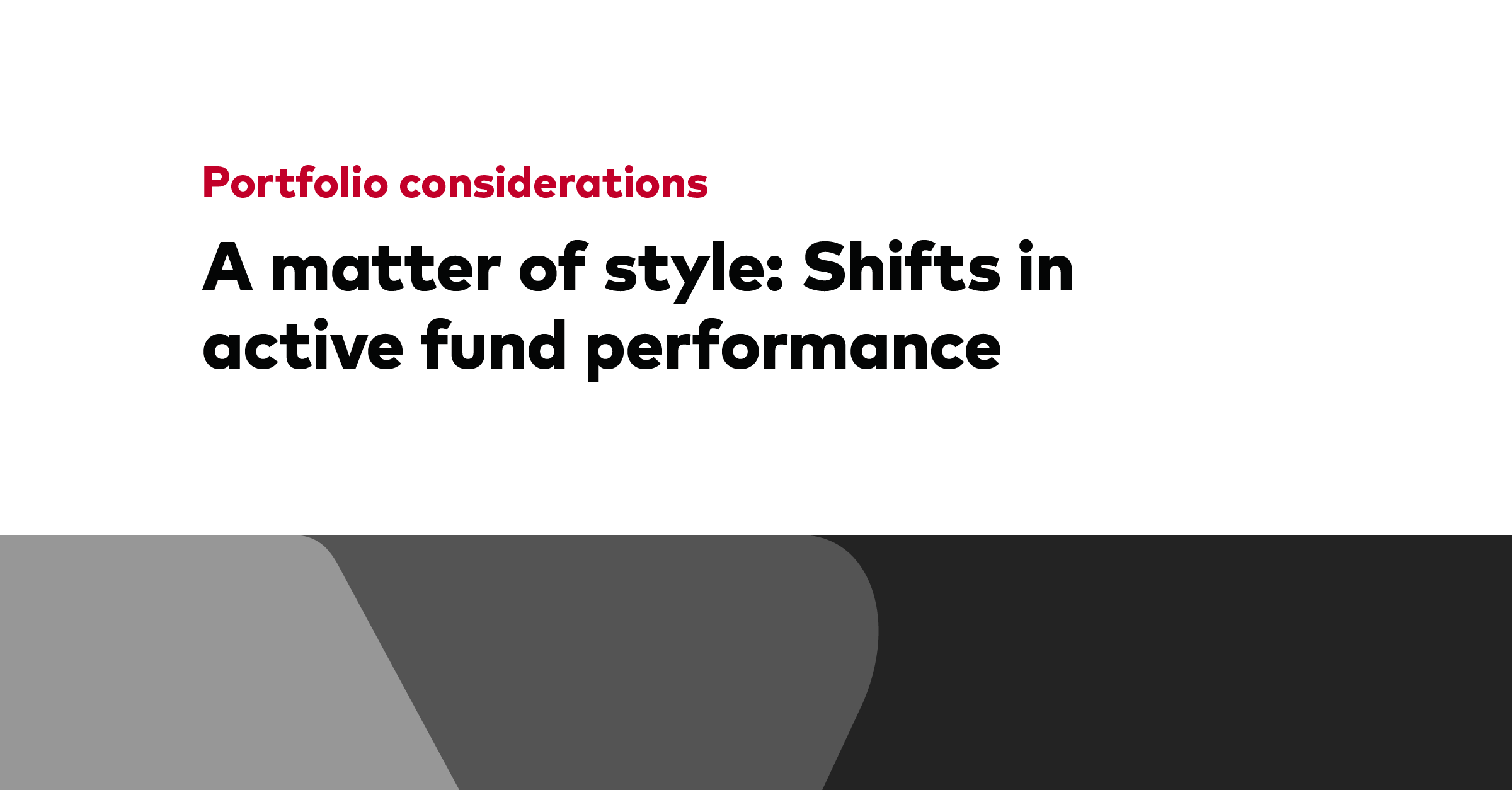Expert insight
Active fixed income ETFs gain momentum
April 21, 2025
At Vanguard, we know that the less investors pay in fees, the more of their returns they get to keep. When it comes to active fixed income ETFs, cost efficiencies beyond a low expense ratio can help investors’ bottom line.
Cost efficiencies are built into the Vanguard ETF creation and redemption process, which can help an active ETF outperform its index and, potentially, a mutual fund based on a similar strategy. To draw the comparison, David Sharp, Vanguard’s ETF Capital Markets director explains how index ETFs are traded.
Simplified bond baskets for efficient ETF trading
Any index-based fixed income ETF may have holdings that comprise most of its benchmark. The Bloomberg U.S. Aggregate Float Adjusted Index, which Vanguard Total Bond ETF (BND) seeks to track, contains more than 13,000 bonds. However, market-maker firms providing liquidity to the market may not have access to all those bonds. Furthermore, the cost of acquiring them would be prohibitive.
Regarding BND, for most creation sizes, we will ask for a basket of 100 to 200 bonds that represent the index's credit quality, duration, industry sector, and other attributes. This sampling strategy allows the market maker to deliver a representative slice of the fund, thereby lowering their operational costs. In addition to the smaller basket, the market maker can also propose their own bond inventory, which helps them reduce the creation costs even more. These procedures allow our ETFs to trade efficiently, with a small bid/ask spread and limited premium/discount volatility.
Vanguard sets the minimum creation unit size at 100,000 shares for our broadest ETFs, such as BND or Vanguard Intermediate-Term Bond ETF (VCIT), to achieve the proper diversification of bonds in the basket. Our developed creation process, high secondary volume, and strong liquidity of the investment-grade benchmarks allow our funds to trade efficiently at a low cost to investors.
Aiming to outperform the market
However, active portfolio managers (PMs) aren’t trying to track an index. They want to outperform it. This vital difference allows market makers and investors to reach a better deal.
For instance, Vanguard only asks for a minimum of 5,000 shares in one creation unit from a market maker to create shares in Vanguard Core Bond (VCRB) and Vanguard Core-Plus Bond (VPLS) ETFs.1 We also provide market makers with the flexibility to create with cash or by offering inventory to a creation in-kind.
With cash creations, instead of negotiating which bonds to deliver (based on what market makers can access or have in their inventory), we’ll accept cash instead and buy the bonds we prefer, charging market makers a small fee for the convenience. This cash exchange keeps market makers’ costs low, which in turn helps to keep investors’ fees low as well.
Market makers can still create shares in our active ETFs with in-kind creations if it’s convenient or economically beneficial for them. It helps PMs better manage portfolios by accepting only the bonds they want without paying transaction costs to buy them directly.
Conversely, in-kind redemptions also allow PMs to remove bonds without selling them, which would trigger a taxable distribution—one structural advantage ETFs have over mutual funds.
Three key investor benefits of Vanguard ETFs
- Lower spreads. The overall difference between the bid and ask price should remain tight because market maker costs are low. According to Bloomberg data, we’ve averaged a 3.6-cent bid/ask spread since the launch of VCRB and VPLS through February 28, 2025. This competitive spread has lowered the total cost of ownership for investors.
- Potentially better returns. When investors purchase a mutual fund, they buy it at the net asset value, which is determined by the bids of the bonds in the portfolio. However, the PMs may incur costs to buy the bonds on the offer, which can impact performance. In contrast, our active ETFs charge a fee to the market maker to create in cash, which allow the PMs to offset the cost of the trading activity. This can be a tailwind to better portfolio performance.
- More flexibility to be active. Our active PMs have more flexibility to deploy cash, potentially creating “trade alpha” for a portfolio when executing cash creations. When completing in-kind creations, PMs can focus on the bonds in a market maker’s inventory with a strong perceived relative value. This flexibility can help deliver better returns as they take advantage of market opportunities.
How is active different?
Note: ETFs listed are Vanguard Core-Plus Bond ETF (VPLS), Vanguard Core Bond ETF (VCRB), Vanguard Mortgage-Backed Securities ETF (VMBS), Vanguard Short-Term Inflation-Protected Securities ETF (VTIP), Vanguard Intermediate-Term Treasury ETF (VGIT), Vanguard Intermediate-Term Corporate Bond ETF (VCIT), and Vanguard Total Bond Market Index ETF (BND).
Source: Vanguard.
These key benefits can be counteracted by poorly executed ETF trades, especially if the trade is significant. Vanguard’s Capital Markets Team can assist those executing large trades. An example of how this played out occurred in September 2024, when the team helped an investor execute a trade for 5.8 million VCRB shares. Even though the 1-year-old ETF (inception: 12/31/2023) is still relatively lightly traded, the ability of a market maker to create the ETF allowed the investor to execute their trade 3 cents per share below the prevailing ask price, resulting in a positive outcome.
In this case, the market maker could sell to the client at an attractive price and then create ETF shares with Vanguard to deliver to the client. They were not beholden to the perceived lower liquidity of the product’s average daily volume.
Best possible execution in a thinly traded ETF

Source: Vanguard
Index or active: Choosing the right ETF
Index fixed income ETFs remain solid investment vehicles. They offer predictability and precision, allowing investors to tailor portfolios for duration, credit, and sector exposures.
For many years, index fixed income ETFs were essentially the only ETF option, and they remain the standard in many client portfolios. Active PMs were initially reticent to offer the daily transparency of their holdings to the market. But those concerns have now been overcome.
Active fixed income ETFs are the new trend in bond investing. For investors who prefer an active approach to investing and ETFs for portfolio construction, active fixed income ETFs can be the simple solution.
1 Vanguard Core Bond ETF and Vanguard Core-Plus Bond ETF share the benchmarks, management teams, and expense ratios of AdmiralTM Shares of Vanguard Core Bond Fund and Vanguard Core-Plus Bond Fund, respectively. However, they are separate and distinct products. Natural differences in total asset size, client cash-flow activity, and other factors will result in differences in fund holdings and, in turn, differences in fund performance between the corresponding ETFs and mutual funds, particularly over shorter time periods.
Notes:
For more information about Vanguard funds or Vanguard ETFs®, visit vanguard.com or call 800-662-7447 to obtain a prospectus or, if available, a summary prospectus. Investment objectives, risks, charges, expenses, and other important information about a fund are contained in the prospectus; read and consider it carefully before investing.
Vanguard ETF Shares are not redeemable with the issuing Fund other than in very large aggregations worth millions of dollars. Instead, investors must buy and sell Vanguard ETF Shares in the secondary market and hold those shares in a brokerage account. In doing so, the investor may incur brokerage commissions and may pay more than net asset value when buying and receive less than net asset value when selling.
Vanguard Core Bond ETF and Vanguard Core-Plus Bond ETF are not to be confused with the similarly named Vanguard Core Bond Fund and Vanguard Core-Plus Bond Fund. These products are independent of one another. Differences in scale, certain investment processes, and underlying holdings between the ETFs and their mutual fund counterparts are expected to produce different investment returns by the products.
All investing is subject to risk, including possible loss of principal. Diversification does not ensure a profit or protect against a loss.
Bond funds are subject to interest rate risk, which is the chance bond prices overall will decline because of rising interest rates, and credit risk, which is the chance a bond issuer will fail to pay interest and principal in a timely manner or that negative perceptions of the issuer’s ability to make such payments will cause the price of that bond to decline.

